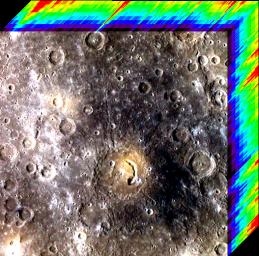
|
Cubist Cube
- Click the image above for a larger view
- Full-Res JPEG (527 x 521) (91.4 kB)
- Full-Res TIFF (527 x 521) (824.8 kB)
Caption:
Near the middle of this image is a crater with a comma-shaped pit. The crater is named for Picasso , the renowned painter who was a pioneer of the Cubist style. The image has been processed to illustrate the three-dimensional nature of color image data. The MDIS camera captured images of Mercury's surface through eight different color filters. By aligning all the images so that the same feature on the ground is at the same pixel position in each image, a data product called a "multispectral image cube" is created. The cube has two dimensions of spatial information, with the third axis being the spectral (color, or wavelength) dimension. The rainbow color scale along the top and right edges of the image represents the reflectance values in each of the eight filters, with low values as black and purple and higher values as red. The reflectance generally increases from the shortest wavelength (433 nm) to the longest (996 nm).
This image set was acquired as part of MDIS's 8-color base map. The 8-color base map is composed of WAC images taken through eight different narrow-band color filters and covers more than 99% of Mercury's surface with an average resolution of 1 kilometer/pixel. The highest-quality color images are obtained for Mercury's surface when both the spacecraft and the Sun are overhead, so these images typically are taken with viewing conditions of low incidence and emission angles.
Date acquired:
September 16, 2011
Image Mission Elapsed Time (MET):
224676534
Image ID:
767576
Instrument:
Wide Angle Camera (WAC) of the Mercury Dual Imaging System (MDIS)
WAC filter:
996-nm, 749-nm, 433-nm as red-green-blue.
Center Latitude:
5.17°
Center Longitude:
49.68° E
Resolution:
1246 meters/pixel
Scale:
The scene is about 615 km (380 mi.) across.
Incidence Angle:
50.2°
Emission Angle:
0.2°
Phase Angle:
50.3°
Background Info:
The MESSENGER spacecraft is the first ever to orbit the planet Mercury, and the spacecraft's seven scientific instruments and radio science investigation are unraveling the history and evolution of the Solar System's innermost planet. Visit the Why Mercury? section of this website to learn more about the key science questions that the MESSENGER mission is addressing. During the one-year primary mission, MDIS acquired 88,746 images and extensive other data sets. MESSENGER is now in a year-long extended mission, during which plans call for the acquisition of more than 80,000 additional images to support MESSENGER's science goals.
These images are from MESSENGER, a NASA Discovery mission to conduct the first orbital study of the innermost planet, Mercury. For information regarding the use of images, see the MESSENGER image use policy .
Cataloging Keywords:
| Name | Value | Additional Values |
|---|---|---|
| Target | Mercury | |
| System | ||
| Target Type | Planet | |
| Mission | MESSENGER | |
| Instrument Host | MESSENGER | |
| Host Type | Orbiter | |
| Instrument | Mercury Dual Imaging System (MDIS) | |
| Detector | Wide Angle Camera (WAC) | |
| Extra Keywords | Color, Crater, Map, Radio | |
| Acquisition Date | ||
| Release Date | 2012-04-05 | |
| Date in Caption | 2011-09-16 | |
| Image Credit | NASA/Johns Hopkins University Applied Physics Laboratory/Carnegie Institution of Washington | |
| Source | photojournal.jpl.nasa.gov/catalog/PIA15580 | |
| Identifier | PIA15580 | |
